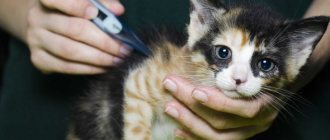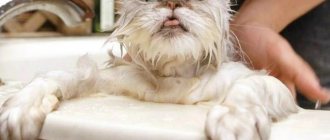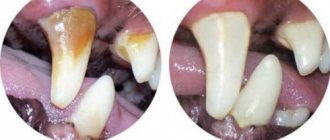Everyone who has a cat knows that animals want not only affection and love, but also care. Perhaps you are just planning to adopt a kitten into your family, or if you have already adopted a little furry one, then you naturally have various questions about caring for a new family member. An important point in caring for an animal is the correct and timely trimming of a cat’s claws.
The article below discusses the topic of nail trimming for kittens and adults. From it you will learn why to do this and with what tools. You will also read whether the breed of the animal is related to claw trimming and much more. Happy reading!
Why trim your nails?
This question interests all cat owners. Domestic cats need to have their claws cut because, unlike street animals, they do not walk on asphalt, stones, or climb trees, where they can take care of their claws themselves. Long claws interfere with the movement of pets and also cause them discomfort. If you do not trim your animal's claws, there is a chance that it will begin to sharpen them on upholstered furniture. But you don’t want this outcome, do you? Therefore, to make life easier for the animal and you, carry out this procedure at an early age.
But if you sometimes let your cat out on the street, then do not cut the claws, because the animal needs them for protection. Even partially outdoor cats can take care of their claws themselves, actively running and climbing trees.
If your pet occasionally goes outside, you are putting him at great risk. As a result, the animal will become easy prey for dogs. And with the help of sharp claws, the cat will protect itself from dogs and other cats.
Why trim your cat's claws?
The joy of acquiring a furry neighbor is often replaced by concerns about the animal’s behavior. If a cat has not been accustomed to a scratching post since childhood and is inclined to swing its paw at the owner’s hand, there is a risk of getting an unpleasant surprise in the form of frequent scratches. Trimming cat claws is necessary and can be done at home:
- If your pet has an increased interest in furniture, this can completely ruin a sofa, armchair, set, or even renovations.
- If the pet has an aggressive character and has repeatedly scratched and injured its owners, family members and guests.
- If your pet is participating in shows: show breeds (British, Russian Blue, Maine Coon) may be disqualified for having untrimmed nails.
- There are pathologies in which animals have deformed phalanges and claws that grow into the paw pads. In this case, trimming the claws is a necessary procedure.
IMPORTANT: claws are an important tool of feline nature. Animals use their claws to hunt, climb to surfaces, and defend themselves. Completely declawing a pet is inhumane and unsafe for the animal's future life.
Nail trimming is a safe and necessary procedure for domestic cats.
At what age can you cut your hair?
The second most important question in this matter is: when should you start trimming your nails? Some veterinarians suggest accustoming an animal to trimming its claws from 2-3 months, others from 3-4 months. This is the optimal age for introducing the procedure into animal care. The sooner you start doing this, the faster your pet will get used to these actions and at the sight of scissors or nippers he will not hiss, bite or hide from you, hoping that you will leave him alone. After all, the older the pet, the more difficult it will be for him to get used to the haircut.
Nail trimming and breed
You may be wondering: is there a connection between breed and how often you trim your nails? Veterinarians will tell you that it all depends on the breed of the animal. Therefore, this factor affects how often you trim your pet's nails.
So, according to veterinarians, British dogs should have their nails trimmed every three weeks, as in this breed they grow back quite quickly.
Nail trimming for a Briton
For example, Scottish cats have claws that grow more slowly. In this regard, trimming the claws can be done less frequently. The main thing is to monitor the condition of the nail plate and the pet’s paws in general.
Representatives of the Persian or Sphynx breeds have claws that grow faster than those of other cats. Therefore, monitor nail growth and treat them every two weeks.
The main thing is not to overdo it. It is better to cut less, but more often. If you cut off too much of the nail, you risk injuring the animal. Be careful!
But do not forget that each pet is individual. And therefore, all domestic cats require an individual approach
How to cut your hair correctly: main steps
If this is your first time cutting your cat's claws, take the time to look at the angle at which it should be done. An incorrectly chosen angle can lead to delamination of the animal’s claws. Another important rule: cut only the part that is rounded. Looking at the claw, you may notice that there are blood vessels there. It is important not to hurt them! This will cause discomfort and pain to your pet.
How to trim claws correctly
How to trim a cat's claws yourself?
Preparation begins at the moment when the animal does nothing: does not eat, does not sleep, does not play and does not lick itself. Take your pet in your arms, talk affectionately and communicate. Lightly touch the paw pads, massage them, while trying to distract your pet's attention. It is advisable to enlist the help of someone whom the cat knows and trusts.
- Place your pet on a stable surface.
- Take the paw, gently massage and press on the pads, do this with each paw.
- If your pet reacts well and doesn’t break out, give him a treat.
Below you will learn how to trim a cat's claws using scissors and a nail clipper at home.
How to properly trim a cat's claws with scissors at home
Prepare:
- Scissors (blister)
- File
- Cotton pad
- Hydrogen peroxide
Before the procedure, wash your hands, clean and disinfect instruments.
The pink part is the vessels and pulp
- Carry out the procedure in a room with good daylight.
- Sit comfortably and place the cat on your lap, stroking and calming your pet.
- Take the paw in your hand, massage it, and as soon as the cat releases its claws, start trimming.
- After trimming your pet's claws, treat them with a file so that the animal does not cling to surfaces.
The photo shows a diagram of how to properly trim a cat's claws without damaging the pulp.
IMPORTANT: take special care if the cat’s claws are black - leave extra length for safety.
Do-it-yourself haircut with a nail clipper
A nail clipper allows you to safely trim your nails to the desired length. Using a nail clipper, it is almost impossible to accidentally injure an animal, but you should cut carefully so as not to touch the blood vessels.
Prepare:
- Claw clipper
- File
- Cotton pad
- Hydrogen peroxide
Before the procedure, wash your hands, clean and disinfect instruments. Next, follow the familiar instructions:
- Choose a well-lit room.
- Sit the animal on your lap, calm and stroke it.
- Allow your cat to release her claws by gently pressing on the pads of her paws.
- Carefully guide the movements of the nail clipper at the correct angle so that after the procedure the claw resembles an “arrow”.
You can leave extra length to be on the safe side.
Using a nail clipper
Before using the nail clipper, treat its surface with an alcohol-containing product, which will help prevent infection.
Take the time to wash your hands before trimming your nails and rinse them with a disinfectant to prevent the spread of any infection.
What tools can you use to trim a cat's claws? Can I cut my hair with regular scissors?
Any owner wants to know how to cut their pet's nails. Nowadays there are different devices for cutting hair. It all depends on the desire of the owner, and which of the devices will be more convenient for him to use.
It's not a good idea to trim your pet's nails with regular nail scissors that you use on yourself. Since the nail plate of humans and animals is different, it is better to choose a special nail clipper for your pet. But if you don't have tools designed specifically for your animal, make sure your regular scissors are well-sharpened and not loose. The quality of the device determines how the procedure will go.
Scissors
One of the options for trimming cats' claws is specially shaped scissors. They differ from ordinary ones in that they have a rounded end, which is shaped like a cat's claw.
Nail trimming scissors
Guillotine
The name of this device may put you off buying it. But don't panic! It will not cause any harm to your pet if used correctly. The guillotine operates on the principle of scissors. She removes the excess part of the nail. If you still don’t like the name, you can choose another tool that interests you.
Guillotine
Secateurs
Another device that may scare you with its name. Outwardly, it resembles a garden device of the same name. Only cat claw pruners are smaller in size and have a different shape of scissor blades, at the end of which there is also a special cutout in the shape of a cat's claw.
Secateurs
Grinder
An electric scratching post resembles a polishing file that people use for manicures. Only the device for cats has less power. It works on the principle of grinding down an animal's claws. This device is usually used in veterinary clinics and animal salons. The tool comes with stoppers for safe filing of claws. But if this is the first time in your life that you are giving your pet a manicure, use a different tool, since the grinder requires skill and experience.
Grinder
File
This tool will help you finish trimming your pet's nails. The file operates on the same principle as a human file: it grinds down the sharp edges of the claws after they are cut with some kind of nail cutter.
File
There are times when owners do not want to trim their cats' claws. For this case, veterinarians came up with claw covers. These are caps that are attached to the glue that comes with the kit. The animal needs time to get used to the anti-scratch. If the pads are glued correctly, they will not cause harm or danger to your pet. They will fly off on their own along with the keratinized part of the nail, so this manicure must be carried out regularly and not miss the moment.
Anti-scratch
Rules
Every owner should know how to properly trim a cat’s claws, since this procedure is required
animal regularly.
The entire manipulation can be divided into several stages:
- Wash your hands and disinfect the tools.
- After the animal is securely fixed, you should take the paw and press on the pads of the toes so that the claw comes out and is clearly visible.
- The tool should be positioned at right angles to the nail being trimmed, from top to bottom.
- If the claw is light-colored, then trimming is done within 1 - 2 mm of the pink area. If there is pigmentation, cut 1 - 2 mm from the tip of the nail, being careful not to touch the capillary. Typically, dark nails are trimmed in stages to prevent bleeding.
- The nail should be trimmed in one step (in one motion).
You should not delay the manipulation so as not to irritate your pet. If a blood vessel is accidentally damaged, apply a cotton pad soaked in hydrogen peroxide or chlorhexidine solution to the nail to stop the bleeding. If the damage is significant, you should contact a veterinary clinic. But, as a rule, with some skill and experience, the procedure is quick and painless.
To learn how to properly trim a cat's claws, watch this video:
How to prepare a cat for the first procedure?
You should not trim the claws if your dog is too active and excited, as he may mistake it for violent actions, which will scare him away more. Therefore, choose a time when the kitten is calm, or better yet, when he is very tired. This way he won’t try to escape and won’t get too stressed. Remember the following rule: do not make slow movements when trimming nails, as this may begin to irritate the animal. It will begin to get nervous and break out of the owner’s hands, which will subsequently lead to damage or even injury.
Pet your pet, give him his favorite delicacy. By appeasing your pet, it will be easier for him to make contact with you, and he will be less aggressive before starting the procedure.
And most importantly, you need to talk to the animal. After all, he is also a living creature and loves when the owner speaks to him kindly.
Advice! Remember, the calmer the owner, the more obedient the animal.
So prepare yourself in advance, calm down and tune in, because an animal, even a small one, understands the feelings of its owner.
If the animal still breaks out and becomes nervous, do not yell at it. This will make him even more nervous, which will frighten the animal in the future during the next haircut.
You might think your friend is in pain during the procedure. But if you do everything correctly and at the same time without sudden or too slow movements, then your pet will be satisfied.
If the cat is not given?
Cats, like people, have different types of personalities. There are particularly nervous and aggressive animals that do not even allow the owner to touch their paws. Alternatively, nail trimming for these pets should be done by two family members, one holding the cat and the other trimming the nails. You can also swaddle your pet with a soft towel or sheet.
Aggressive cat
If the cat still behaves aggressively and stubbornly breaks out, you should not use force, since trimming the claws can lead to paw injuries. It is better to interrupt the procedure and do it when the pet is in a calmer state.
What to do if damaged?
If, however, damage occurs to the animal while trimming its nails, stop immediately and begin treating the injury or wound. To begin, prepare some cotton pads and anti-bleeding agents so you have everything at hand. If the injury is more serious than you thought, try to stop the bleeding and go to the vet. He will tell you what to do and what to do next.
Once you've finished trimming his nails, treat your friend to his favorite treat.
Advice: do not force the animal to cut its nails and do not mock it while trimming its claws, because this way it will avoid not only this procedure, but possibly you as well.
But if you still do not plan to do the first procedure on your own, carry out this haircut under the supervision of a veterinarian. A certified specialist will tell you how to handle the tool and the animal, and tell you how to avoid injuries. He will also give advice on how to make the procedure less stressful for all participants in the process.











